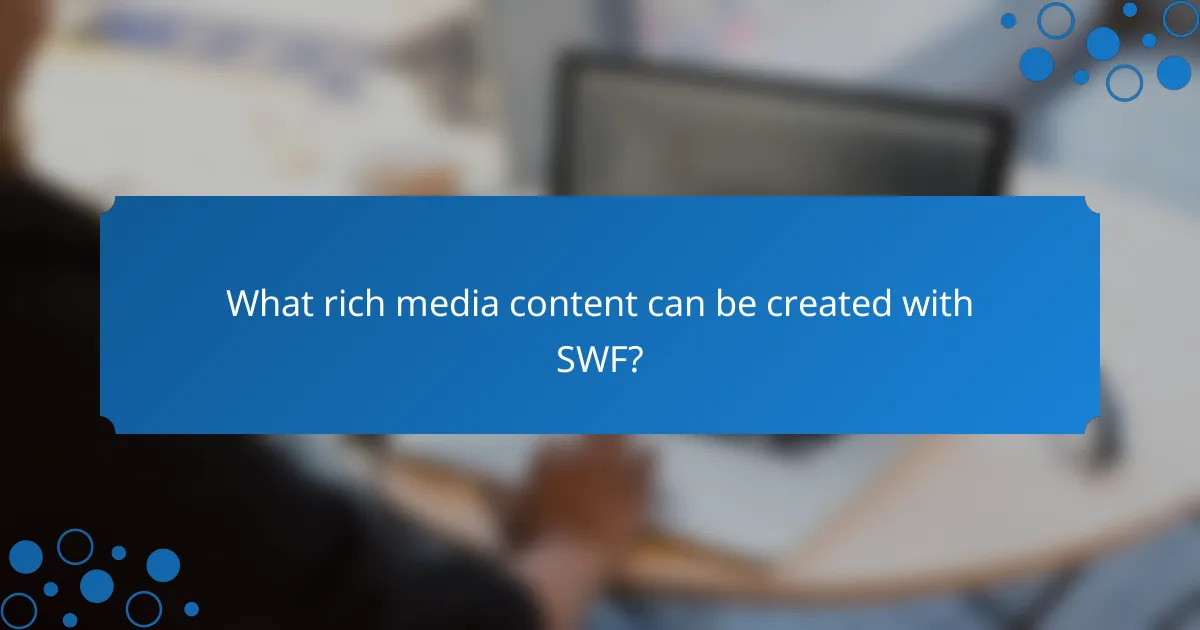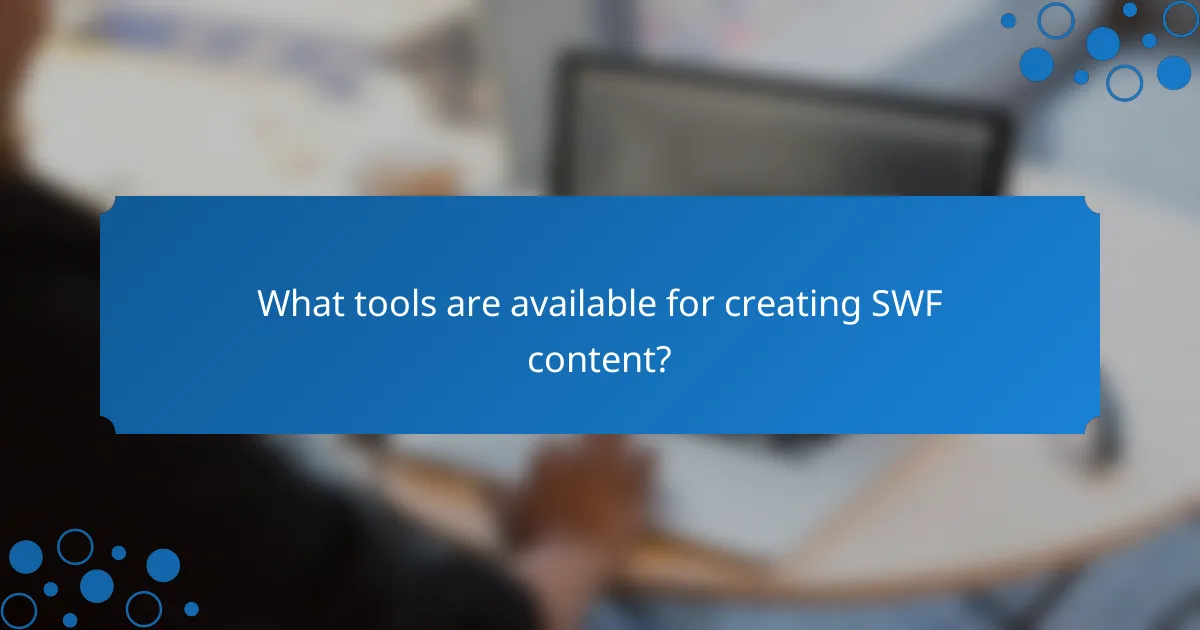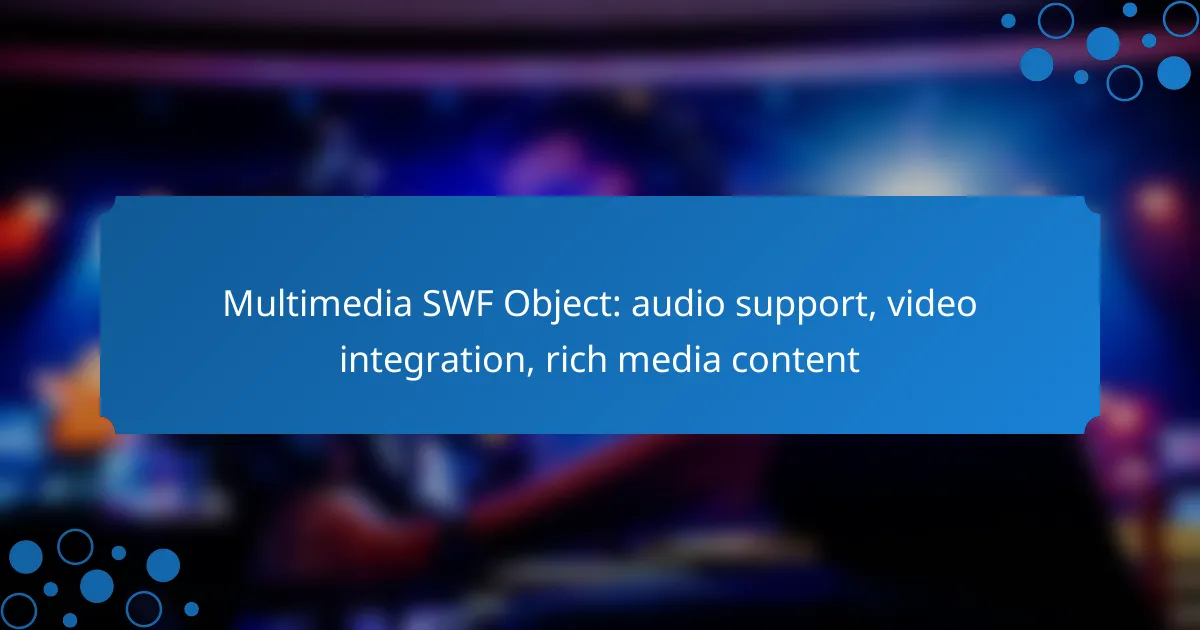SWF (Small Web Format) files are powerful tools for creating rich multimedia content, including interactive animations, games, and data visualizations. By integrating audio support and video using formats like FLV, developers can enhance user engagement and provide a dynamic experience. Utilizing ActionScript for audio playback and optimizing video controls ensures smooth performance and a captivating user experience.

How to integrate audio support in SWF objects?
Integrating audio support in SWF objects involves using ActionScript to control audio playback and embedding audio files directly into the SWF. This allows for a richer multimedia experience, enhancing user engagement through sound.
Using ActionScript for audio
ActionScript is the programming language used in Adobe Flash for controlling audio playback. You can use it to load, play, pause, and stop audio files, as well as to manage volume and other playback settings. For example, the Sound class allows you to create sound objects and control their behavior programmatically.
When using ActionScript, ensure you handle events properly, such as loading completion and playback errors. This will enhance the user experience by providing feedback and managing expectations during audio playback.
Embedding MP3 files
Embedding MP3 files in SWF objects is a straightforward process that allows for seamless audio integration. You can import MP3 files directly into your Flash project and use ActionScript to control their playback. This method is efficient as it reduces the need for external file management.
To embed an MP3 file, simply drag the audio file into the library panel in Flash, then use the attachSound method in ActionScript to link it to a sound object. Keep in mind that file size can affect loading times, so optimize your audio files for better performance.
Streaming audio solutions
Streaming audio solutions enable real-time playback of audio content without requiring full downloads. This is particularly useful for applications like online radio or music streaming services. You can use protocols like RTMP (Real-Time Messaging Protocol) to stream audio effectively within SWF objects.
When implementing streaming audio, consider the bandwidth and latency of your users. Providing options for lower bitrate streams can enhance accessibility for users with slower internet connections. Additionally, always test your streaming solution across different devices to ensure compatibility and performance.

What are the best practices for video integration in SWF?
To effectively integrate video in SWF, focus on using the FLV format, implementing user-friendly controls, and optimizing for performance. These practices ensure a smooth playback experience and enhance user engagement with rich media content.
Using FLV format for video
The FLV (Flash Video) format is widely recognized for its compatibility with SWF files, making it a preferred choice for video integration. This format supports high-quality video while maintaining relatively small file sizes, which is crucial for web applications.
When using FLV, ensure that your encoding settings balance quality and size. Aim for a bitrate that provides clear visuals without excessive loading times, typically ranging from 500 kbps to 1500 kbps depending on the resolution.
Implementing video controls
Providing intuitive video controls enhances user experience by allowing viewers to play, pause, and adjust volume easily. Consider including buttons for full-screen mode and a progress bar to track playback.
Use ActionScript to create custom controls that match the design of your application. Ensure that these controls are accessible on both desktop and mobile devices to cater to a wider audience.
Optimizing video for performance
Performance optimization is essential for smooth video playback in SWF. Start by compressing your video files to reduce load times, which can be achieved through various encoding tools.
Additionally, consider using progressive downloading instead of streaming for better performance in environments with limited bandwidth. Test your video on different devices and connections to ensure consistent playback quality.

What rich media content can be created with SWF?
SWF (Small Web Format) files enable the creation of various rich media content, including interactive animations, games, and data visualizations. These multimedia elements enhance user engagement and provide dynamic experiences across web platforms.
Interactive animations
Interactive animations created with SWF allow users to engage with content in a dynamic way. These animations can respond to user inputs, such as mouse movements or clicks, making them ideal for educational tools or promotional materials.
When designing interactive animations, consider the balance between visual appeal and performance. Keep file sizes manageable to ensure quick loading times, ideally under a few hundred kilobytes, to enhance user experience.
Games and simulations
SWF is widely used for developing browser-based games and simulations, offering a platform for rich graphics and sound. These games can range from simple puzzles to complex simulations that mimic real-world scenarios.
To create engaging games, focus on intuitive controls and responsive design. Ensure that the gameplay is smooth and that the SWF file is optimized for various devices, aiming for compatibility across desktops and mobile platforms.
Data visualizations
SWF can effectively present data visualizations, transforming complex datasets into interactive graphs and charts. These visualizations help users comprehend trends and insights quickly, making them valuable for business reports and educational purposes.
When developing data visualizations, prioritize clarity and interactivity. Use color coding and tooltips to enhance understanding, and keep animations subtle to avoid distracting from the data itself. Aim for visualizations that load within a few seconds to maintain user interest.

What tools are available for creating SWF content?
Several tools are available for creating SWF content, each offering unique features for multimedia integration. Popular options include Adobe Animate, Google Web Designer, and Swiffy for conversion, which cater to different levels of expertise and project requirements.
Adobe Animate
Adobe Animate is a leading tool for creating interactive SWF content, allowing users to design animations and integrate audio and video seamlessly. It supports vector graphics and offers a timeline-based interface, making it accessible for both beginners and advanced users.
When using Adobe Animate, consider its extensive library of assets and templates, which can speed up the design process. However, be mindful of the learning curve associated with mastering its features, especially for complex projects.
Google Web Designer
Google Web Designer is a free tool focused on creating HTML5 content but can also export to SWF format. It provides a user-friendly interface with drag-and-drop functionality, making it suitable for those who prefer a simpler approach to multimedia design.
This tool is particularly useful for creating responsive designs and animations that work across various devices. However, its capabilities for audio and video integration may not be as robust as those found in Adobe Animate.
Swiffy for conversion
Swiffy was a tool developed by Google to convert Flash SWF files into HTML5, allowing for easier integration into modern web environments. While it has been discontinued, it served as a bridge for users transitioning from Flash to HTML5.
For those still working with SWF files, consider using alternative conversion tools that maintain the integrity of animations and multimedia elements. Always test the output to ensure compatibility with current web standards and devices.

What are the limitations of using SWF objects?
SWF objects have several limitations that can hinder their effectiveness, including compatibility issues with modern browsers, security vulnerabilities, and the discontinuation of Flash Player support. These factors can significantly impact the usability and accessibility of rich media content.
Browser compatibility issues
SWF objects may not function properly across all browsers, particularly as many modern browsers have phased out support for Flash. Users on platforms like Chrome, Firefox, and Safari may encounter difficulties accessing SWF content, leading to a fragmented user experience.
To mitigate these issues, consider using HTML5 as an alternative for multimedia content. HTML5 is widely supported across all major browsers and provides similar functionalities without the drawbacks associated with SWF objects.
Security vulnerabilities
SWF objects are often associated with security vulnerabilities that can expose users to risks such as malware and data breaches. These vulnerabilities arise from outdated Flash Player versions and the inherent weaknesses in the SWF format itself.
To protect users, it is essential to avoid using SWF objects for sensitive applications. Regularly updating software and transitioning to more secure formats like HTML5 can help minimize security risks.
End of life for Flash Player
The official end of life for Flash Player occurred at the end of 2020, meaning Adobe no longer provides updates or support for the software. This discontinuation has rendered SWF objects increasingly obsolete, as users are encouraged to uninstall Flash Player to avoid security issues.
Transitioning to modern web standards is crucial for maintaining functionality and security. Developers should focus on converting existing SWF content to HTML5 or other supported formats to ensure ongoing accessibility and performance.
